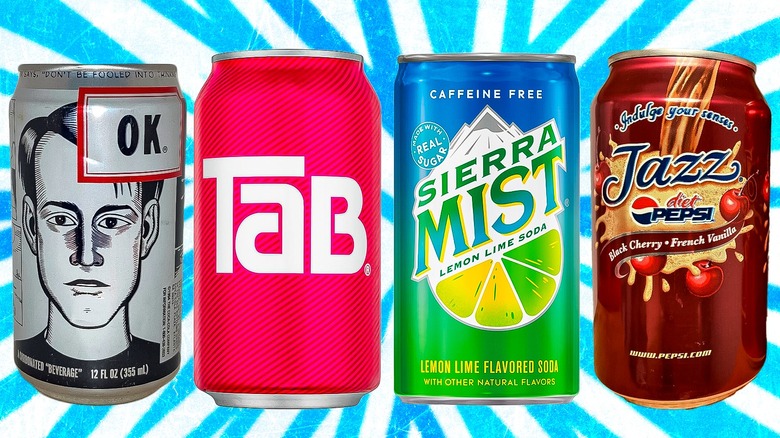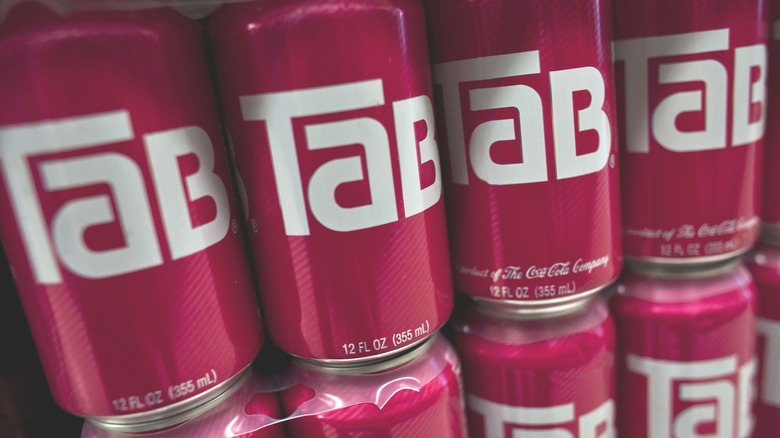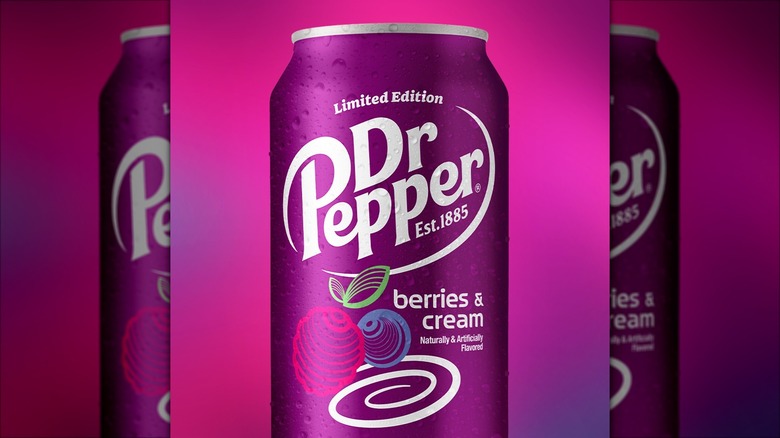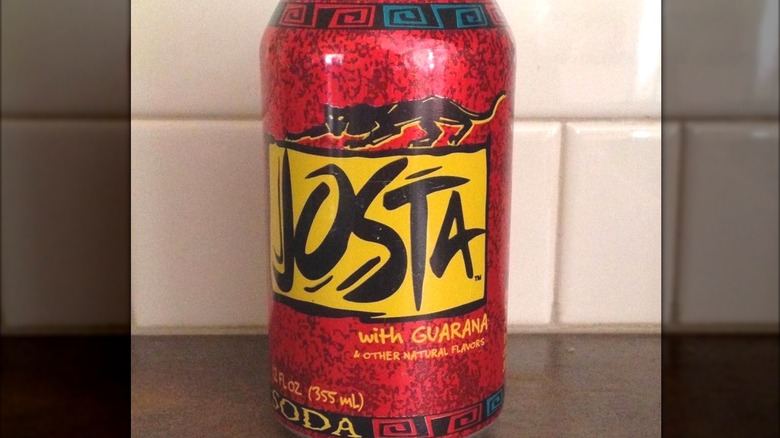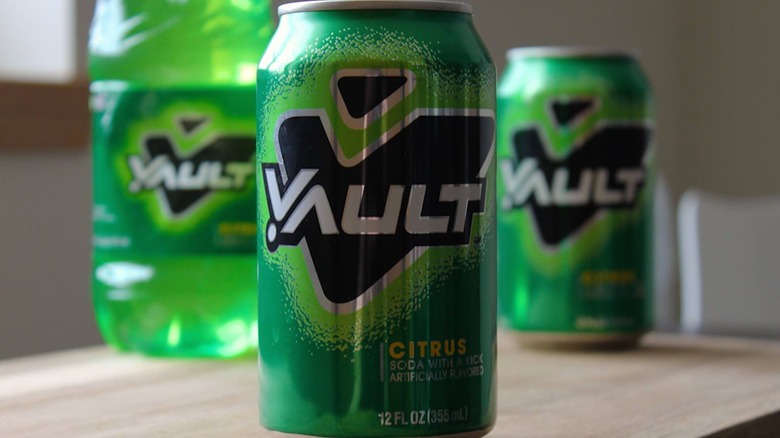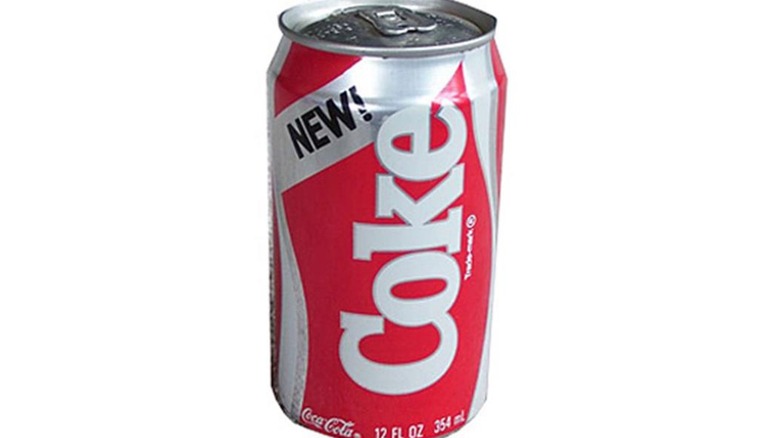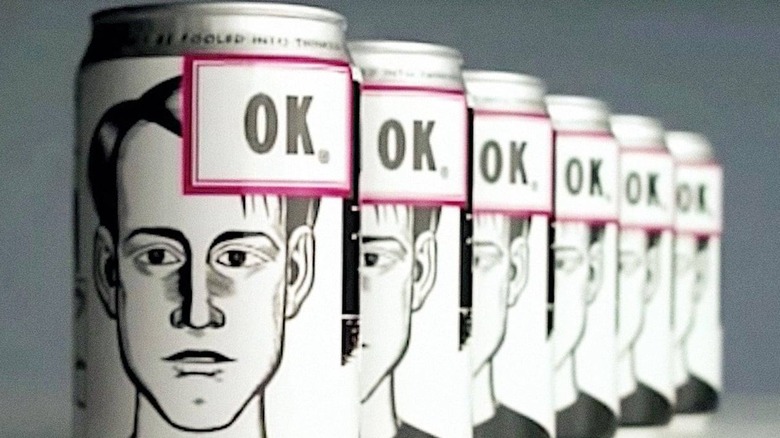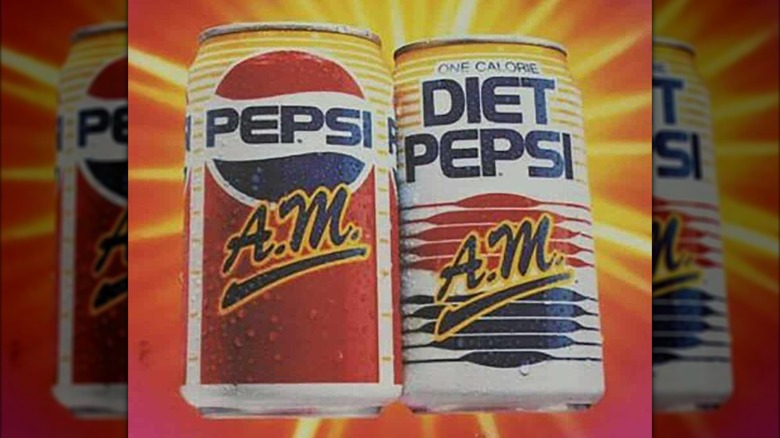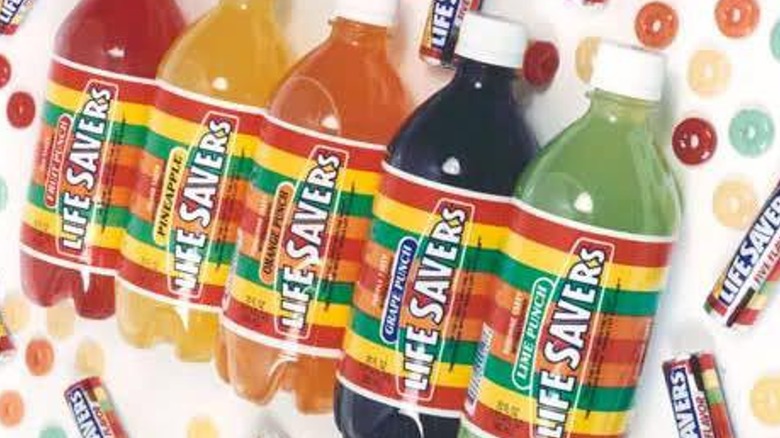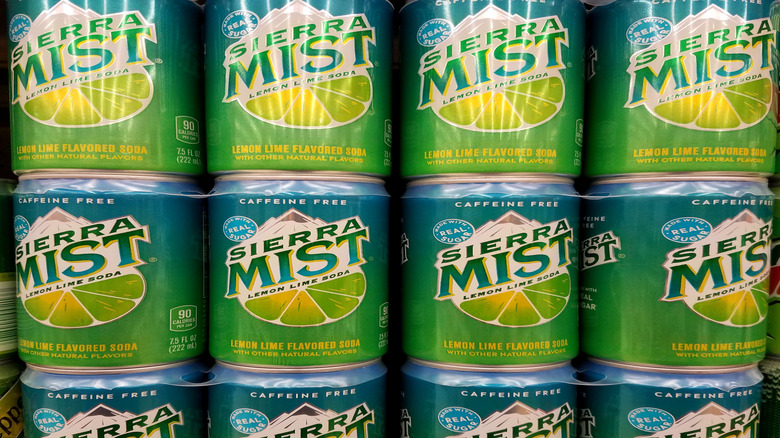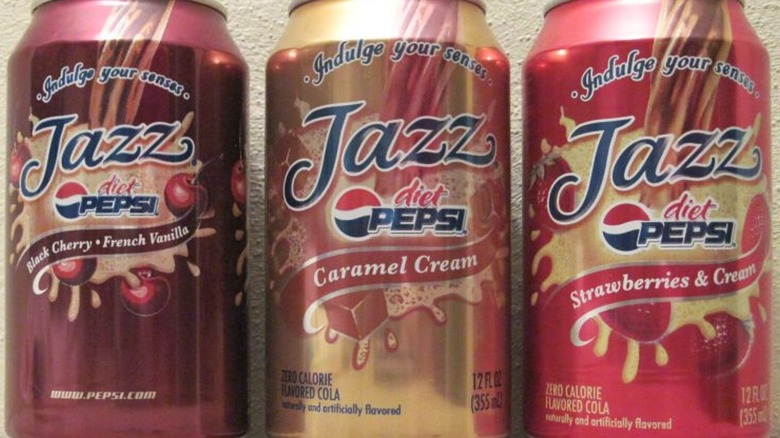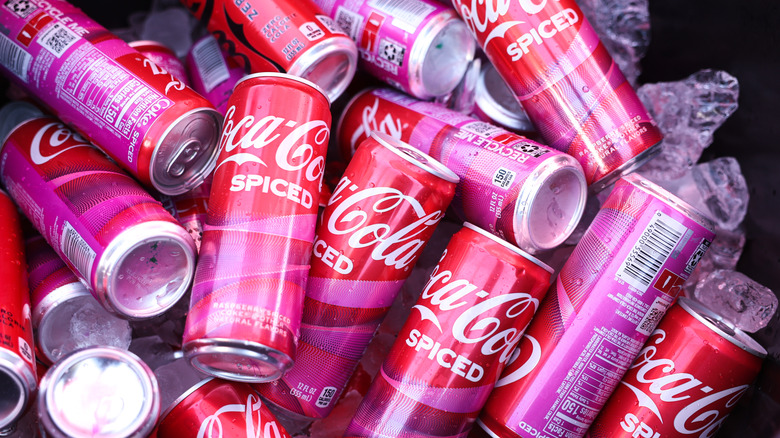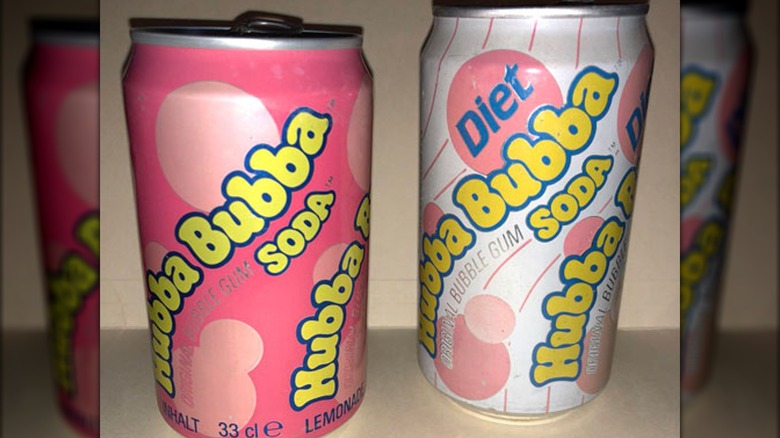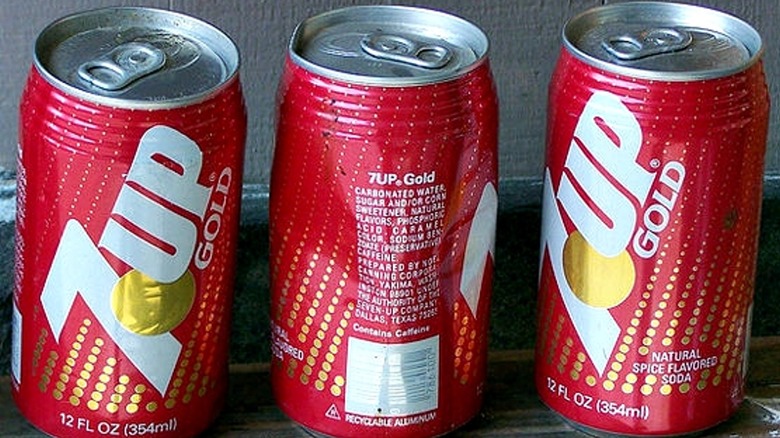Discontinued Sodas That Are Probably Never Coming Back
It's never a good feeling to find out your favorite food or beverage is discontinued, especially if that item holds sentimental value. Soda is no exception — over the years drink companies have introduced and then quietly retired numerous different types of soda. Some of these sodas had attracted a strong fan base that mourned their loss, while others disappeared without much protest from anyone.
It's true — some once-beloved sodas, like Surge or Slice, have managed to work their way back into relevance, returning to store shelves after years of absence. However, not every soda is as lucky. Whether due to shifting consumer interests, new health trends, or increased competition, some beverages are fated to remain a distant memory. To honor these old favorites (and bring attention to those that probably never should have seen the light of day), we put together a list of sodas that are unlikely to ever return. Some have been gone for decades, while others were canceled surprisingly recently.
TaB
The Coca-Cola Company launched TaB in 1963 as a healthier alternative to its other offerings. TaB became the company's first diet soda, reaching its height of popularity in the '70s and '80s when diet drinks were all the rage. Fans have described the soda as having a bitter, metallic taste, thanks to the saccharin — an artificial sweetener — used in the original formulation. While it was an acquired taste, TaB attracted a strong and loyal fanbase. When Diet Coke was introduced in 1982, TaB was the most popular diet soda on the market. However, Diet Coke quickly took over, and TaB saw its sales begin to dwindle.
TaB fans were dealt another blow when the soda's recipe changed in 1984 to include aspartame, another artificial sweetener. This caused many fans to abandon the brand. Over the years, it became increasingly difficult to find TaB in stores, and Coca-Cola finally pulled the plug in 2020. In a press release, the company explained it was reshaping its beverage portfolio by cutting underperforming products and refocusing on its leading brands. Still, this news rocked TaB's small but vocal fanbase, sparking a movement to bring their beloved soda back. However, despite a Change.org petition with over 7,500 signatures, Coca-Cola has not budged on its decision. In 2022, a company spokesperson told CNN Business, "there are no plans to bring [Tab] back." Unfortunately for fans, this one seems to be a lost cause.
Dr. Pepper Berries & Cream
In April 2006, Dr. Pepper launched a brand-new flavor called Berries & Cream. The soda, a mix of blueberry, raspberry, and vanilla flavors, joined the brand's permanent line-up, with a diet version launching alongside it. The flavor even came with its own slogan, "Get Berried in Cream," though this would all be short-lived. Only about six months after its release, Berries & Cream was discontinued due to underwhelming sales numbers.
Despite its short run, Dr. Pepper Berries & Cream became a favorite flavor for many. Luckily for fans, the soda was briefly revived in 2022 as an award for the Pepper Perks program. However, the flavor returned to retirement once the sweepstakes ended. While some might take this short comeback as a good sign for the flavor, fans shouldn't get their hopes up. In 2023, Dr. Pepper released a similar but slightly different flavor: Strawberries & Cream. With this flavor now a permanent offering, it seems unlikely that Dr. Pepper would bring back Berries & Cream at the same time. While nothing is certain, it looks like fans will have to make do with Strawberries & Cream for the foreseeable future.
Josta
When PepsiCo launched Josta in 1995, it made history as the first energy drink introduced by a leading U.S. beverage brand. This innovative soda featured both caffeine and guarana, a plant from the Amazon that's naturally high in caffeine. Fans have said this drink tasted similar to cola but had a stronger, fruitier flavor, reminiscent of berries. While ads for the drink urged customers to "better do the good stuff now," Josta failed to sell as well as PepsiCo hoped.
In 1999, PepsiCo announced it was discontinuing Josta, blaming a shift in corporate strategy. Devastated fans immediately started a campaign called "Save Josta," which still exists to this day. In 2007, fans even organized a National Josta Day to bring awareness to their cause. Despite these efforts (and a recent cameo in Disney+'s Loki series), Pepsi has remained silent on the possibility of bringing back the soda. At this point, 25 years later, things aren't looking too hot for Josta fans. Although Josta was ahead of its time in the '90s, today the energy drink market is just as saturated as anything else.
Vault
As energy drinks were becoming increasingly popular in the early 2000s, Coca-Cola was itching to capitalize on this new phenomenon. In 2005, the company launched Vault, a hybrid between an energy drink and a traditional soda. Fans have described the drink as unlike anything else on the market, boasting a bold, complex citrus flavor with a full-bodied profile. Vault was also available in a variety of other flavors. While some considered Vault the spiritual successor to Surge, a citrus soda discontinued in 2003, Vault contained higher caffeine and carbonation levels. An 8-fluid-ounce can of Vault packed 47 milligrams of caffeine, which isn't that much compared to today's standards. For instance, an 8.4-fluid-ounce can of Red Bull contains 80 milligrams of caffeine.
Unfortunately, Vault never developed the same following that Surge had, also failing to compete with PepsiCo's Mountain Dew. In 2011, the soda was discontinued. One theory is that the soda's neon green color repelled customers, who potentially felt it was too unnatural looking to drink. Whatever the case, the soda disappeared from store shelves and hasn't been seen since. While some fans have gathered over 7,200 signatures on a Change.org petition to bring the drink back, it seems unlikely that Vault would fit in with today's range of energy drinks.
New Coke
In the '70s and '80s, PepsiCo was a rising star in the soda industry. To make matters worse for rival Coca-Cola, the company was conducting blind taste tests with consumers, revealing that most people favored the taste of Pepsi over Coke. In April 1985, Coca-Cola decided to make a huge change: release a new and improved Coke formula. While the company had adjusted its signature drink's recipe since its debut in 1886, the core flavors always stayed the same. New Coke, however, was a far cry from the original Coke flavor, tasting sweeter and closer to Pepsi.
Unsurprisingly, this change didn't go over well. Loyal Coke fans were distraught by the new flavor and were quick to voice their complaints, organizing protests and calling the Coca-Cola company around 8,000 times per day by June. Fans were so upset that they dumped the newly formulated soda in sewers and hoarded cans of the old recipe. After only 77 days, Coca-Cola hastily re-released the original recipe as "Coca-Cola Classic" to appease fans. The Classic formula instantly overtook New Coke in sales, returning once again to the number one spot in cola sodas. In 1990, the company renamed New Coke as Coke II, but this didn't help its reception. The soda was discontinued for good in 2002 due to low sales. Given the overwhelmingly negative reaction from the public, a return in this day and age seems improbable for New Coke.
OK Soda
In 1993, Coca-Cola introduced OK Soda, an attempt to reach the Generation X audience. The story goes that Coca-Cola found that the only word more widely recognized than "Coke" was "OK." So, the company went all in with nihilistic marketing and branding, decorating its cans with bleak art and messaging like "What's the point of OK? Well, what's the point of anything?" While this approach was meant to appeal to a cynical younger audience, the campaign fell flat.
Marketing decisions aside, the soda itself wasn't a winning formula. Its own ads described it as "carbonated tree sap," a comparison that certainly doesn't inspire confidence. Those who tried it have said it tasted like a mixture of several different sodas, including Sprite, Coke, and orange soda. Despite expectations that OK Soda would capture 4% of the beverage market, the drink narrowly achieved half of that goal, underperforming across all test markets. Only seven months after its launch, OK Soda was discontinued. Given this massive failure, and the fact that no one is exactly clamoring for a comeback, we'll bet on this one staying a strange blip of the past.
Pepsi A.M.
In 1989, PepsiCo executives thought that consumers were ready to take their soda drinking to the next level. This led to the creation of Pepsi A.M., the first soda designed specifically to be enjoyed in the morning. Sounds like a great idea, right? What set this soda apart was its caffeine content — Pepsi A.M. packed an impressive 25% more caffeine than your standard can of Pepsi. Taste-wise, the drink was indistinguishable from regular Pepsi.
Pepsi A.M. and Diet Pepsi A.M. (a drink boasting only one calorie) first became available in certain test markets across the United States. The soda targeted coffee drinkers, hoping to break into a morning beverage market that had long eluded soda makers like Pepsi or Coca-Cola. However, consumers just couldn't get behind the idea of guzzling down soda first thing in the morning. Only a year after its release, in 1990, Pepsi A.M. was axed due to lower-than-expected sales. This was not PepsiCo's only attempt to push drinks for the morning. However, as none of these attempts have proven successful, Pepsi A.M. will remain an odd but interesting footnote in soda history.
Life Savers Soda
Life Savers, those ring-shaped rainbow candies that come in cylinder-shaped packs, are beloved by many. These delicious sweet treats seem like the perfect inspiration for a new soda flavor — so what could go wrong? In 1995, Life Savers unveiled a line of sodas based on its candies, with flavors that included Orange Punch, Pineapple, Grape Punch, Lime Punch, and a red-colored Fruit Punch. The soda came in bottles and cans that mimicked the candy wrapper's striped appearance.
While the soda performed well in product taste testing, real life would be a different story. Consumers reacted poorly to the drink, feeling as if they were drinking melted candy. Those who tried it have confirmed that it tasted like sugar in a can. Apparently, it didn't taste close enough to actual Life Savers candy — in fact, many consumers found the drink to be disgusting. So, it's no surprise that the soda was quickly discontinued. All things considered, Life Savers soda may go down as one of the worst beverage ideas to ever hit store shelves.
Sierra Mist
It may come as news that Sierra Mist is no longer with us. The lemon-lime soda was discontinued in 2023 after a decades-long uphill battle with competing soda brands. It all started when PepsiCo debuted Sierra Mist in 1999 to compete with 7UP and Sprite, the leaders in the lemon-lime soda game. Previous attempts to break into the market, including Slice and Teem, weren't as successful as the company hoped. The main difference with Sierra Mist is that it used real cane sugar, which contributed to its distinct taste. Fans of the soda have recalled its use of cane sugar fondly, while others asserted that it tasted like an inferior version of Sprite.
Unable to catch up to 7UP and Sprite, PepsiCo tried rebranding Sierra Mist in the mid-2010s, changing its name to Mist Twst. Unsurprisingly, it didn't make much of a difference. After experiencing further drops in popularity in the last few years, Sierra Mist was finally retired in January of 2023. At the same time, PepsiCo announced the launch of Starry, a new lemon-lime soda. Unlike Sierra Mist, Starry is sweetened with high fructose corn syrup. With Starry now on the market, Sierra Mist fans likely won't see their favorite soda return any time soon.
Diet Pepsi Jazz
When Diet Pepsi Jazz launched in the summer of 2006, it was meant to reinvigorate the company's cola lineup. The new soda came in three flavors: Black Cherry and French Vanilla, Caramel Cream, and Strawberries and Cream. PepsiCo was actually able to trademark the word "Jazz" for these new sodas. The almost-century-old word had never been trademarked, making it fair game for PepsiCo to stick it on a new zero-calorie soda line.
However, despite PepsiCo calling Jazz "The New Sound of Cola," the flavors weren't popular with consumers. Those who tried them found all three varieties to be disappointing, especially Caramel Cream, which most people have agreed was revolting. At best, some consumers thought the fruit flavors were drinkable but nothing special. In early 2008, Diet Pepsi Jazz was discontinued, potentially so the company could focus on Diet Pepsi Max, a soda that entered the U.S. market in 2007. Though PepsiCo predicted that its sodas would jump to the forefront of everyone's minds at the mention of "Jazz," the cola line has since faded into a distant memory. Maybe that's for the best.
Coca-Cola Spiced
Coca-Cola Spiced is another recently discontinued soda. While the flavor, launched in February 2024, was advertised as a permanent offering, it had a surprisingly short run. After only six months on the market, Coca-Cola decided to cut its losses. "We're always looking at what our customers like and adjusting our range of products," a spokesperson told CBS Moneywatch. "As part of this strategy, we're planning to phase out Coca-Cola Spiced to introduce an exciting new flavor in 2025."
The main issue with Spiced was its misleading name. Instead of a spicy beverage, Spiced combined the classic Coke taste with a raspberry twist. The soda received mixed feedback from consumers, with some enjoying its pronounced raspberry flavor and others comparing it to cough syrup. Spiced was an attempt by Coca-Cola to appeal to Gen Z consumers, many of whom have defected to prebiotic soda brands like Poppi or Olipop. Unfortunately, the soda didn't connect with consumers as well as expected, making it unlikely to return in the near future. Only time will tell whether Coca-Cola's newest incoming flavor, Orange Cream, will fare better than Spiced.
Hubba Bubba Soda
Back in 1988, Hubba Bubba temporarily veered into the beverage industry, releasing a soda version of its signature pink bubblegum. According to those who had the opportunity to try the soda, it tasted incredibly sweet, like a can of liquid sugar. Just in case you were wondering, the novelty soda also came in a diet version made with the artificial sweetener aspartame, making it more accessible for all Hubba Bubba fans.
Unfortunately, this soda didn't last long on store shelves. While not much is known about why the drink was discontinued, it likely didn't perform well in sales numbers. We can only imagine that it was an odd experience drinking something bubblegum-flavored instead of chewing it. After all, swallowing your bubblegum just feels wrong. While exact dates are unclear, the soda had disappeared from stores completely by the early '90s. Although the soda had its fans, there hasn't been too much demand for it to make a comeback. This one will most likely stay a curiosity of a long-gone era.
7UP Gold
Most people know and love 7UP for its lemon-lime soda. While experimenting with other flavors is nothing new for 7UP (it currently offers a cherry soda), the brand made a misstep with its decision to launch 7UP Gold. Released in 1988, this new flavor was a big departure from regular 7UP. It was a dark-colored soda but not a cola — instead, it was flavored with ginger and cinnamon, similar in taste to a ginger ale. Fans of the soda recall its sweet, spicy notes, saying it was completely different from anything else on the market.
While reportedly tasty, the flavor didn't fit in well with 7UP's beverage lineup. The soda's dark color and bold, spicy flavor profile strayed too far from the brand's signature lemon-lime taste. Plus, while regular 7UP is caffeine-free, 7UP Gold contained caffeine. At the time of the new flavor's release, "Never Had It, Never Will" was a slogan used to market 7UP, with the "it" referring to caffeine.
Understandably, 7UP fans didn't respond well to Gold. One year after its release, 7UP Gold held only 0.1% of the soda market. To no one's surprise, the flavor was soon discontinued, vanishing from stores in 1989. Today, though many may remember the soda fondly, it doesn't have a very vocal fanbase demanding that 7UP bring it back. As of writing, there are no plans for the soda to return.
